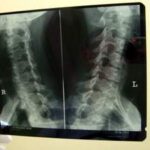Cervical dystonia is a movement disorder affecting the nervous system that causes severe pain as the neck is forcibly twisted to one side of the body. In some cases, the head can be forcibly tilted to the back or front of the body as well. Also referred to as spasmodic torticollis, this condition is incurable and can be life-altering. According to movement disorder neurologists at the Mayo Clinic, cervical dystonia most commonly occurs in middle-aged women, although it can occur at any age and in either gender, even in infancy.
Signs & Symptoms
One of the major symptoms of cervical dystonia is obvious twisting of the neck to either side of the head or either to the back or the front of the body. Other symptoms include neck pain, including spasms of the neck muscles and pain that often extends to the shoulders. Cervical dystonia also causes headaches in many sufferers, and some even experience severe migraines. Some other symptoms are twitching and pulling sensations in the neck muscles, and squeezing of the head. Stress and certain movements tend to aggravate the condition, as rest and sleep improves symptoms.
Diagnosis
Unfortunately, since cervical dystonia is such a rare condition and many physicians don’t know a great deal about it, many sufferers can go for years without an accurate diagnosis. There is no one definitive test to diagnose cervical dystonia, although an electromyography or EMG, a special electrical test that determines the amount of activity in muscles, may be helpful. The physician will also look at the family history, blood tests, EEG and MRI of the brain to assist with diagnosis. A thorough neurological examination is necessary, and sometimes a muscle biopsy is performed in order to examine muscle, nerve and skin tissue of the neck.
Cause
Doctors aren’t sure what exactly causes cervical dystonia, but there are some theories. One theory is that certain toxins can build up in the body and cause this condition. Another theory is that it’s caused by an abnormality in the functioning of the basal ganglia, which is connected to the cerebral cortex in the brain. The basal ganglia is responsible for controlling movement within the body. Yet another theory is that cervical dystonia is a genetic condition, but research is currently being conducted in order to find more effective treatments as well as a definite cause.
Treatment
There is no one treatment that works for everyone with cervical dystonia, and in most, many medications and treatment options must be tried before one is found that actually provides lasting relief. Medications such as anticholinergics, which are intended to block certain neurotransmitters, benzodiazepines such as ativan, klonopin, and valium, which can cause depression, drowziness, and addiction, as well as some other medications.
According to the Dystonia Medical Research Foundation, botulism injections were discovered as a treatment for cervical dystonia in the late 1980s. One of two types of botulism, is injected directly into the affected muscles of the neck, where it relieves the pain and contractions caused by the condition by temporarily weakening the muscles. This form of treatment is very popular and sometimes works wonders for sufferers of cervical dystonia, and is the treatment of choice when straightening of the neck is necessary.
Physical therapy is often helpful in some cases, for helping to retrain muscles to refrain from spasming, and is sometimes beneficial in alleviating pain. Therapy consists of application of heat as well as various exercises to strengthen the neck and its various muscles.
Surgery, although rare, may sometimes be necessary to treat those with cases that are resistant to other forms of treatment. Surgeries include deep brain stimulation, which works by stimulating a certain part of the brain that controls movement, selective peripheral denervation, where certain nerves connected to malfunctioning muscles are severed, as well as surgeries that purposely damage particular parts of the brain that may be the cause of cervical dystonia.
Prognosis
As long as proper diagnosis is made, people with cervical dystonia are expected to live normal lives, as the condition itself is not life-threatening. It is imperative, however, that anyone suspecting that they suffer from this condition be diagnosed as soon as possible, because years of being undiagnosed can be deadly, as some sufferers’ quality of life is so poor or non-existent that they often contemplate suicide. Cervical dystonia can be a miserable disorder, but with aggressive treatment it can be managed, giving the person a normal quality of life.



